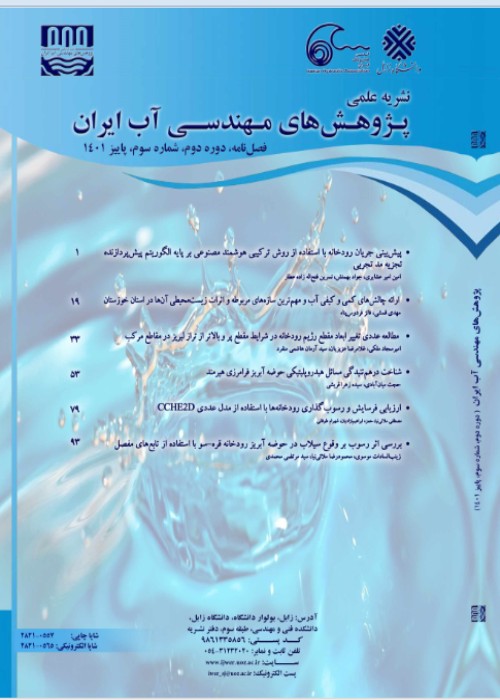Effects of the simultaneous presence of bridge pier and abutment on the change of erodible bed; using FLOW-3D
The scouring mechanism at the abutment is very similar to the pier of a bridge; such that the decrease in current intensity near the upstream of the abutment, a vertical pressure gradient is created, this pressure gradient moves downwards to become the initial vortex, the size of which expands with the development of the scour cavity (Melville, B.W. 1997).The bridge pier near the abutment causes deepening of the scour near the support (Hong, S. 2005). However, the scouring depth is determined prominently by the scouring of the abutment and that this value may be greater than the scouring depth of a pedestal alone (Nyarko, K., & Ettema, R. 2011; Karami et al., 2017).The length of the abutment has an essential effect on its scouring depth, such that by doubling the length of the abutment, the scouring increases by about 18 times and decreases with decreasing abutment distance (Arab and Zomordian 1393; Anjum Rooz et al., 2017).In the present study, we applied FLOW-3D to build a numerical model to investigate the effect of changing the piers' distance from the abutment on the scour depth and scour rate around the two piers.
Flow-3D is one of the most potent applications in computational fluid dynamics. This research makes applications to solve the mean Navier-Stokes equations of time (Reynolds equations) using the finite volume method under a rectangular grid on the base of the Eulerian theory.The flow continuity equation is written as Equation 1. FLOW-3D calculates the load transport of each sediment type, including bedload transport, separately. FLOW-3D calculates the load transport of each sediment type, including bedload transport, separately. The dimensionless form of the bed load transfer rate in terms of n is written by Equation 2, in which dn is obtained from Equation 3.We used the laboratory results obtained from the research conducted by Hosseini et al. (2016) to validate the numerical model and adopted the study undertaken by Khosronejad et al. (2012) to model the pier scour. A rectangular channel with a length of 6 meters, a width of 1.21 meters, and a height of 0.45 meters; was used to model the bridge pier and abutment. Fig. 2 shows the rectangular channel a pier and abutment placed in, and Table one describes the model configuration.
For the three-dimensional simulation of flow, the geometry of the field was discretized into a fine mesh. Fig. 2 shows the boundary conditions assigned to the numerical model. Then, three turbulence models, K-ɛ, RNG, and LES have been investigated to compare the maximum scour depth in the rectangular channel for a flow rate of 0.052 m3/s, and their results are shown in Table 3.The results indicate that the LES turbulence model can estimate the maximum scour depth for the bridge pier and the abutment. Although the LES turbulence model takes more time to run, it is more accurate and presents a scouring pattern similar to the following laboratory sample justifying the computational costs. The maximum scour depth at the bridge abutment estimated by the LES model is about 74% of the measured value, while its maximum scour depth measured at the bridge's pier is 87%.Figs 3 and 4 illustrate the bed changes around the abutment and the bridge pier for the numerical and laboratory model. Comparing the bed changes and the location of maximum scour depth for the numerical model of pier and abutment and results of laboratory models shows that the numerical model has a good capability in simulating bed changes and local scour around each of the abutment structures and bridge pier.Comparison of scour time development resulting from numerical models around the abutment and bridge pier with laboratory models, Fig. 6, shows that 70% of the maximum scour depth in the abutment area occurs in 20% of the initial scour time, which is relatively consistent for both numerical and laboratory models.Examination of substrate changes, Figs. 7-11, shows that a deep scouring depth occurred for the abutment and at the upper-right edge of the forehead. And by reducing the pier distance from the abutment in the models, the maximum scours depth around the pier, and abutment structures have undergone significant changes.
Comparing the scour pattern and the location at which the maximum scour-depth for pier and abutment resulted by the numerical model with experimental, shows that the numerical model procured using FLOW-3D can well simulate bed changes and local scour around the bridge pier and abutment. Furthermore, increasing the relative velocity of the flow, strengthening the eddy currents around the pier and abutment, consequently arising the scour depth; as the relative velocity increases by 10%, the scour depth increases by about 50%. Moreover, when the distance from the base to the abutment decreases, the scouring depth around the rectangular abutment increases.
- حق عضویت دریافتی صرف حمایت از نشریات عضو و نگهداری، تکمیل و توسعه مگیران میشود.
- پرداخت حق اشتراک و دانلود مقالات اجازه بازنشر آن در سایر رسانههای چاپی و دیجیتال را به کاربر نمیدهد.


